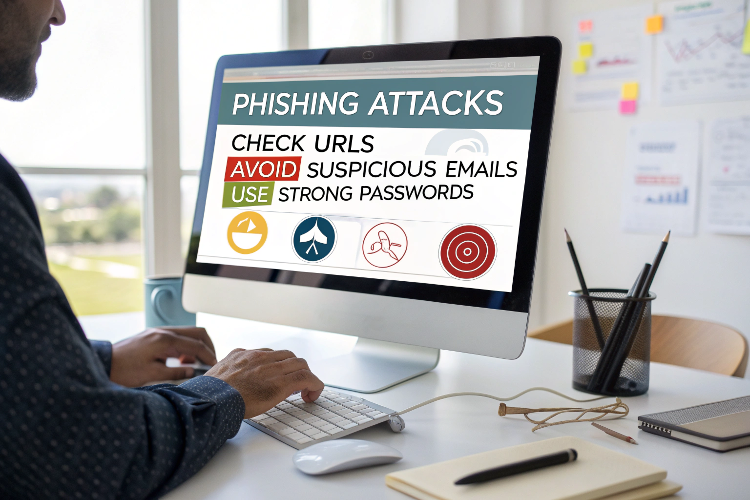Blog
How to Spot & Prevent Phishing Attacks ?
Cybersecurity & Data Privacy ▪ 2025-03-11

In today's digital world, phishing attacks are one of the most common and dangerous cyber threats. Cybercriminals use fraudulent emails, fake websites, and social engineering tactics to steal personal information, financial data, and login credentials.
According to cybersecurity reports, 91% of all cyberattacks start with phishing emails, and phishing scams have caused billions of dollars in losses globally. If you don’t know how to spot phishing attempts, you could easily fall victim to identity theft, financial fraud, or ransomware attacks.
This comprehensive guide will teach you how to identify phishing attacks, prevent scams, and protect yourself from falling victim to cybercriminals.
What is a Phishing Attack?
🚨 Phishing is a cyberattack where hackers trick victims into revealing sensitive information.
✅ Attackers impersonate trusted organizations (banks, tech companies, government agencies, etc.).
✅ They use emails, phone calls, text messages, and fake websites to deceive users.
✅ The goal is to steal login credentials, credit card details, or personal data.
💡 Example: A fake email from "PayPal" asks you to verify your account by clicking a fraudulent link that steals your login details.
🔗 Pro Tip: If an email or message demands urgent action, it’s likely a phishing scam.
1️⃣ Common Types of Phishing Attacks
🔹 1. Email Phishing (Fake Emails)
✔ Attackers impersonate trusted brands and send fraudulent emails.
✔ Emails contain fake links that lead to phishing websites.
✔ Urgent language is used to create panic and force immediate action.
💡 Example: A fake Amazon email claims your account is at risk and asks you to log in.
🔗 Pro Tip: Always verify email senders before clicking any links.
🔹 2. Spear Phishing (Targeted Attacks)
✔ Hackers research specific individuals or companies before launching an attack.
✔ Spear phishing emails appear highly personalized and convincing.
✔ Attackers use social media & leaked data to make emails look legitimate.
💡 Example: A CEO receives an email from a "business partner" requesting sensitive financial documents.
🔗 Pro Tip: Be cautious when receiving unexpected requests for sensitive information.
🔹 3. Whaling (Executive-Level Phishing)
✔ High-profile individuals (CEOs, executives, politicians) are targeted.
✔ Attackers pose as business partners or legal entities.
✔ Hackers aim to steal corporate secrets, funds, or credentials.
💡 Example: A CFO receives a fake email from the "CEO" requesting a large money transfer.
🔗 Pro Tip: Always verify executive emails before sending financial data.
🔹 4. Smishing (SMS Phishing)
✔ Phishing via fake text messages claiming to be from banks, delivery services, or government agencies.
✔ Messages contain fraudulent links or ask for verification codes.
💡 Example: A fake FedEx SMS says your package is delayed and asks you to click a malicious link.
🔗 Pro Tip: Never click unexpected text message links—visit the official website instead.
🔹 5. Vishing (Voice Phishing Calls)
✔ Attackers call victims pretending to be tech support, banks, or government officials.
✔ They use scare tactics to make victims reveal sensitive information.
💡 Example: A fake IRS agent calls, saying you owe back taxes and must pay immediately.
🔗 Pro Tip: Hang up and call the official company number to verify legitimacy.
🔹 6. Clone Phishing
✔ Hackers copy a real email you’ve received and replace links with malicious ones.
✔ Emails look identical to genuine emails from trusted sources.
💡 Example: You get an email from Netflix about an expired payment, but the link steals your credentials.
🔗 Pro Tip: Instead of clicking the email link, manually type the website URL in your browser.
2️⃣ How to Spot a Phishing Attack?
🚨 Red Flags to Look Out For:
✅ Unusual Sender Email Address – Scammers use misspelled or fake email domains.
✅ Urgent or Threatening Language – "Your account will be suspended unless you act now!"
✅ Unfamiliar Greetings & Grammar Mistakes – Professional companies never send poorly written emails.
✅ Suspicious Links & Attachments – Hover over links to check the real URL before clicking.
✅ Requests for Personal or Financial Information – Legitimate companies never ask for sensitive data via email or text.
💡 Example: An email claims "Your PayPal account has been locked!", but the sender's email is paypa1-security@gmail.com (a scam).
🔗 Pro Tip: Always verify links before clicking—hover over them to see the real website address.
3️⃣ How to Prevent Phishing Attacks?
🔹 1. Enable Multi-Factor Authentication (MFA)
✔ Even if hackers steal your password, MFA blocks unauthorized access.
✔ Use Google Authenticator, Microsoft Authenticator, or Authy instead of SMS codes.
💡 Example: Google reports that MFA prevents 99.9% of automated cyberattacks.
🔗 Pro Tip: Enable MFA on all critical accounts (email, banking, social media).
🔹 2. Use Strong & Unique Passwords
✔ Weak passwords are easy targets for credential stuffing attacks.
✔ Use a password manager (Bitwarden, 1Password, LastPass) for secure storage.
💡 Example: Instead of "John123", use "Tq$8pLm&9vZ#P!".
🔗 Pro Tip: Change passwords every 3–6 months for high-risk accounts.
🔹 3. Verify Suspicious Emails & Messages
✔ Don’t trust unexpected messages from banks or online services.
✔ Always visit the official website manually instead of clicking email links.
💡 Example: A phishing email pretending to be Apple asks for your Apple ID login.
🔗 Pro Tip: Call the company directly to verify any urgent security notifications.
🔹 4. Keep Software & Security Updates Enabled
✔ Outdated software contains security holes that hackers exploit.
✔ Enable automatic updates for your operating system, browsers, and apps.
💡 Example: The Equifax breach (2017) happened because the company failed to update its security patches.
🔗 Pro Tip: Enable automatic updates for Windows, macOS, iOS, and Android devices.
🔹 5. Use a Secure Web Browser & Email Filter
✔ Install anti-phishing browser extensions (e.g., uBlock Origin, Norton Safe Web).
✔ Gmail and Outlook have phishing filters that detect fraudulent emails.
💡 Example: Google Chrome’s Safe Browsing feature warns users before visiting phishing websites.
🔗 Pro Tip: Use Firefox or Brave for stronger privacy protection.

